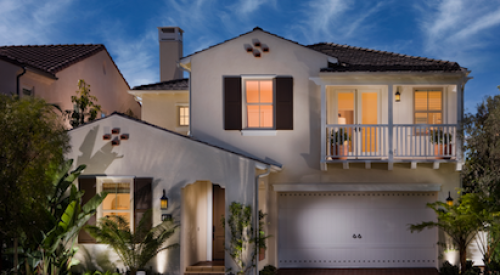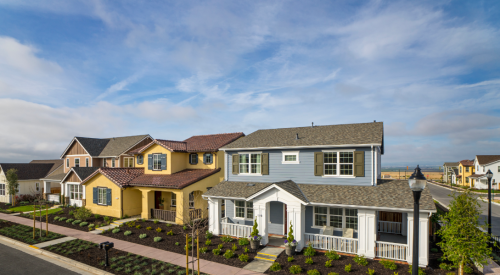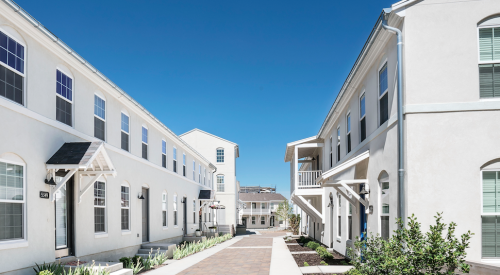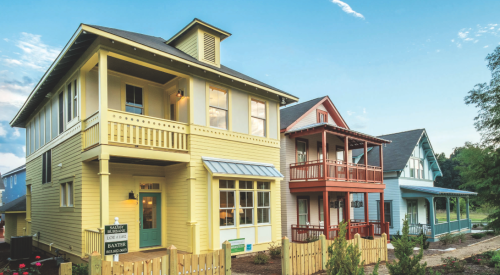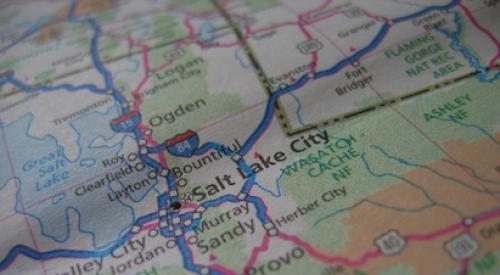|
One of Destination Homes' models in the master-planned community of Daybreak — in South Jordan, Utah — hits buyers' hot buttons in a way that deserves scrutiny.
Daybreak spans 4,126 acres within the western part of the Salt Lake Valley and is surrounded by the Oquirrh Mountains. What's unique about this community is that it is not a collection of miniature neighborhoods built by different builders. Rather, developer Kennecott Land is keeping it as one giant community. Each builder has lots spread around the community, with five or six homes by the same builder in a cluster, but with a different builder across the street.
Opportunities"When we first heard about Daybreak, and what they envisioned for the community, we thought it was going to change the way communities are done in Utah," says Destination president and CEO Brad Wilson.
According to Wilson, Utah has a project called 'Envision Utah' that studies urban planning issues over the next 20 years. There's been a lot of political resistance from other communities to make alterations that drastically change the way we develop, Wilson says, but Daybreak actually represents the intention of the Envision Utah project. "When we first got involved with Daybreak and Kennecott Land, the whole idea was very different from anything we had done, and really, anything that's been done in Utah," says David Bailey, founder of Destination Homes.
Creating an historical look to the community is key. "The architecture specifically is based on historical precedence," says Stephen James, manager of design review for Kennecott Land. "It's mostly pre-war architecture that dates from the turn of the century to mid-century." The different architecture styles include Early Victorian, Mid-Century Bungalow and Craftsman.
Destination did its homework and spent many hours touring historic Utah areas looking for patterns that make neighborhoods and communities great. "We had our architects draw 10 to 12 plans based on exteriors we thought were pleasing, from historical patterns," says Bailey. "But we also wanted to include room sizes and different amenities that are accepted now."
Destination placed the sketched plans in front of two separate realtor focus groups from the area of South Jordan. "We bounced the plans off them and got their feedback on what they thought their clients would like in a number of different aspects," says Bailey.
The result, says architect Randy Lewis of Synergy Design, took elements the focus groups wanted the house to contain, mixed with the requirements Daybreak established and fused to create a new line of historical Utah homes. The Providence is a Craftsman Bungalow that has become the most popular in the line, yet it's easy to build because the architecture is simple as well as historically authentic.
ObstaclesIn the beginning stages at Daybreak, "it was a very challenging time for our company and for most of the [builders], primarily because of the compressed time period that we had to work in," says Bailey. "We had to design an entirely new product line with eight plans, and three elevations each, in a five-month period."
Kennecott set standards for what could and couldn't be done in Daybreak. For Destination, this was a challenge because it hadn't dealt with a number of these demands before. "We had to build four models with new plans and materials we've never used before," says Bailey.
In the past, Destination Homes used stucco for the exterior of its homes. At Daybreak, it used a fiber-cement siding to achieve the historic look of horizontal wood siding.
Destination hesitated to use the fiber-cement siding because it thought there would be resistance from buyers, but quite the opposite happened. "They [buyers] like the ability to customize from the basic tan or beige," says Bailey. "Its more of an authentic look, and authenticity is a big deal in Daybreak."
Sustainable materials were key to Daybreak's overall plan, so Destination incorporated those demands as well. "It was a great experience," says Wilson. "It really helped our company get better."
Sustainable materials had to be either placed in each home, or demonstrated in the models and offered as options.
Another challenge for Destination Homes was the alley-loaded garage. "We don't normally see alley loading in Utah," says Wilson. "It's normally front load, but so far the people have loved the alley load concept."
There are three loading types for the garages in Daybreak: rear-loaded, side-loaded and front-loaded. There's a mix throughout the community to achieve the feel of the community being built over a long period of time.
OutcomeFor Destination Homes, Providence is its best-selling model by far. Approximately 35% of Destination Homes' sales have been Providence plans — 28 Providence models out of 81 sales.
What seems to first draw buyers to the Providence is its large front porch. "Porches were built in the country between 1920 and World War II," says Lewis. Keeping in step with what Kennecott was looking for, Destination felt adding the porch was a nice touch.
The Providence plan has a classic architectural idea behind it, according to Lewis. It opens to a formal living room and dining room. "Some of the interior planning is traditional," says Lewis. "The way the staircase descends into the foyer and the way the staircase interacts with the living and dining room is traditional planning.
"When you get to the back [of the house], that's where the modern elements come in," states Lewis. "It's more contemporary because, typically, old homes don't have large kitchens or big family rooms or the master bedroom on the main floor."
"The thing that takes people's breath away is the kitchen and family room relationship," says Bailey. With its large vaulted ceilings and the openness of the kitchen, it works well for the largest families in the country (which happen to reside in Utah), targeted by Destination.
The upstairs of the Providence has a flexible layout. "The upstairs has one of the bedrooms over the porch, which not only creates more space, but also creates a large roofline," says Lewis.
There's more flexibility upstairs with the loft and how it's used. "Some people would rather have fewer bedrooms and use the loft as another living space for kids to play or do homework," says Lewis.
Providence buyers range from young families to those with teen-age children. Some of the buyers are even empty-nesters that think it's going to be a great house for family gatherings. "We've been a little surprised to have empty-nesters buying a house that big, but they really see this as a great house to bring the family "together."
Another surprise to Destination Homes in the Providence is the number of people wanting to finish the basement. "Probably a quarter to a third of our buyers are finishing the basement in this home and they're having us do it," says Bailey. "It's a pretty big house by the time you do that."
Since taking on Daybreak, Destination Homes is on the fast track to increase its diversity on where it builds. "This was our first shot at being in Salt Lake County and metro Salt Lake," says Bailey. "So far, our margins have been better in the Salt Lake area than elsewhere."
Destination closed about 80 homes in 2004, but plans to exceed that in 2005 by jumping to approximately 200 homes. Bailey says 2004 sales reached $16 million, while the projection for 2005 is $46 million. "In the first quarter, we were over our numbers by almost a $100,000 because our sales prices went up.
|
